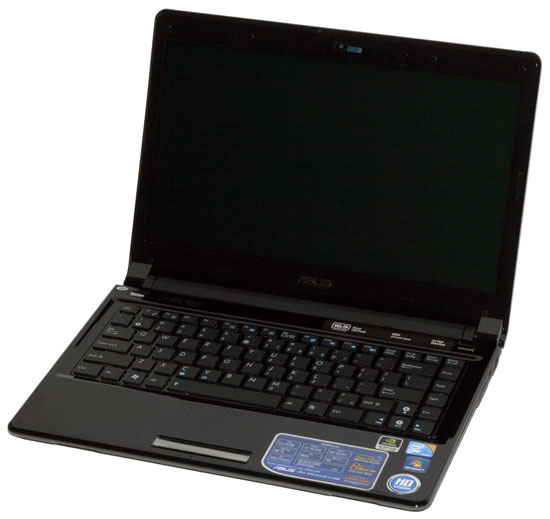ASUS UL80Vt First Look: Mobility Redefined
by Jarred Walton on October 24, 2009 8:00 PM EST- Posted in
- Laptops
Thursday marked the official launch of Windows 7, so perhaps we can finally put those Mac versus PC commercials behind us. Whatever your feelings towards Vista, the fact remains that it garnered a less than stellar reputation. As we discussed in our Windows 7 RC1 article, many people have the impression that Windows Vista is awful but they can't tell you why. Microsoft hopes to change things with the launch of Windows 7, a.k.a. Windows Vista 2.0.
One of the sore spots for Windows, and Vista in particular, has always been battery life. We have discussed this previously, but the simple fact of the matter is that Mac OS X on a MacBook is easily putting any Windows laptop to shame when it comes to mobility. There are many potential contributing factors, including better optimization of the hardware/software combination, tweaks to perhaps enable lower voltages by default on Intel CPUs, and the ability to keep the CPUs running in deeper sleep states more of the time. We will have an updated comparison with OS X in the near future, but to date everything appears to be in favor of Apple MacBook; Windows 7 improves the situation.
Microsoft has a white paper detailing some of the changes in Windows 7 that should result in improved battery life. We have already explored this topic previously, but those are only preliminary results. Moving forward, the laptops we review are going to shift to Windows 7 instead of Windows Vista, and today marks the onslaught of the Windows 7 laptop releases. One of the first Windows 7-based laptops to arrive in our labs for testing comes from ASUS.

We looked at the ASUS UL50Vt running on Windows 7 Home Basic and found that ASUS could deliver nearly 7 hours of battery life while surfing the Internet -- and that's using our heavy Flash-based tests. One of the more interesting aspects of the ASUS UL series is that they allow overclocking of the ULV processors -- typically 1.73GHz instead of the default 1.30GHz, though in low-power states it's also overclocked from 800MHz to 1066MHz. The overclocking is achieved by simply raising the FSB from 800MHz to 1066MHz; since the chipset and other components can all run a 1066FSB already, the only component that's truly overclocked is the CPU, and it has no difficulty running at 1.73GHz.
We have the final release version of the ASUS UL80Vt in our hands, and we have begun testing. Today we provide a quick look at what the laptop offers and our initial impressions.










100 Comments
View All Comments
MrSpadge - Sunday, October 25, 2009 - link
technique = technology *doh*Alexo - Monday, June 28, 2010 - link
Let me add my vote for:- a matte display
- a good display (*VA or IPS)
- a quality keyboard
I am willing to pay for these features and I am sure others will as well.
tmgp - Sunday, October 25, 2009 - link
"We looked at the ASUS UL50Vt running on Windows 7 Home Basic"Does windows 7 home basic exists?... Don't think so
iamezza - Sunday, October 25, 2009 - link
Windows 7 Home BasicWindows 7 Home Basic will be available in emerging markets such as Bangladesh, Brazil, People's Republic of China, India, Indonesia, Italy, Mexico, Pakistan, the Philippines, and Thailand.[13] It will not be available in countries such as Australia, Canada, France, Germany, Ireland, The Netherlands, United Arab Emirates, Saudi Arabia, New Zealand, the United States, and the United Kingdom.[13] Some Aero options are excluded along with several new features.
MadMan007 - Sunday, October 25, 2009 - link
Why is it called the UL80Vt? If that were consistent with the others in the line it would imply an 18" screen. Wierd..strikeback03 - Monday, October 26, 2009 - link
I though the same thing, did they already use UL40Vt on something?codedivine - Sunday, October 25, 2009 - link
I request benchmarks for new Turion II based laptops. Turion II is 45nm based with Phenom based cores. The Athlon QL-64 used here is 65nm bsed and uses K8 cores.I also request benchmarks for the machine HP dm3. It comes in an AMD flavor and a Intel flavor and in the Intel flavor supposedly provides 10 hours of battery life and on AMD about 5.5.
codedivine - Sunday, October 25, 2009 - link
Also, I specifically request Turion II and NOT Athlon II. Athlon II supposedly only have 64b FP units as opposed to full speed 128b FP on Turion II.feelingshorter - Sunday, October 25, 2009 - link
Can we get battery numbers without turbo mode enabled? I don't see why anyone would turn turbo on unless they know they are doing something specifically CPU intensive. Could you please add that to the chart?JarredWalton - Sunday, October 25, 2009 - link
The whole reason for the "first look" is that battery tests are going at a rate of about one per day. It's the blessing and curse of a long battery life, and I like to be thorough. In the full review, I'll provide some figures for with and without Turbo, as well as battery life with the G210M enabled (with and without Turbo if I've got the time...).From what I can see, the Turbo really only accounts for about a 0.5W-1W increase in power draw, so without Turbo battery life might increase to around 560 minutes for Internet surfing, or best-case about 590 minutes. I think idle power draw isn't affected as much (closer to .25W-.5W increase), so without Turbo idle battery life would be in the realm of 800-840 minutes. Obviously, that's still a HECK of a long time. :) I'll get you numbers in about a week or so when I've finished testing.